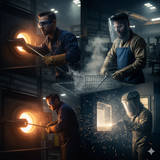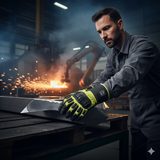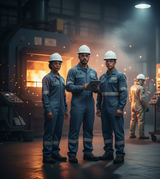Beyond the Hard Hat: Comprehensive Head Protection for Every Workplace Hazard
When we talk about head protection in the workplace, the first image that comes to mind is the classic construction hard hat. While vital for protecting against falling objects, a truly comprehensive head safety program requires looking beyond the traditional hard hat to address a far wider range of hazards—from electrical shock and extreme heat to minor bumps and horizontal impacts.
The reality is that different work environments require different protection. What keeps a construction worker safe from a falling hammer won't protect an electrician from an arc flash or a mechanic from bumping their head on low machinery. Proper head protection is a system of integrated gear designed to mitigate multiple risks simultaneously.
At Your Safety Company, we understand that head safety demands specialization. Let’s explore the essential components of a complete head protection strategy for every hazard your workplace may face.
The Hazards Your Head Protection Must Cover
Head protection must safeguard against more than just vertical impact. A robust program must account for these critical risks:
-
Vertical Impact & Penetration: The risk of objects (tools, materials, debris) falling from above.
-
Lateral Impact: Impact from the side, front, or back, often caused by falls, collisions with equipment, or swinging loads.
-
Electrical Shock: Contact with live circuits, requiring non-conductive materials.
-
Minor Bumping: Head injuries from striking stationary objects (pipes, low ceilings, ductwork) in confined or tight spaces.
-
Thermal Hazards: Exposure to extreme heat, fire, or arc flash energy.
-
Scalp & Hair Entanglement: Risk of hair or scalp being caught in moving machinery parts.
Selecting the Right Gear for the Job
The core of your head protection strategy revolves around three key categories of headgear:
1. Hard Hats (Primary Impact Protection)
Hard hats are classified based on the direction of impact protection and electrical insulation:
2. Bump Caps
-
Purpose: Designed for indoor use where the primary risk is striking a stationary object (like under a hood, near ductwork, or in tight quarters).
-
Limitation: Bump Caps are NOT a substitute for hard hats. They offer no certified protection against heavy falling objects.
3. Specialty Protection
-
Arc-Rated Hoods & Shrouds: Necessary for electrical work in high-risk zones, these are worn over the hard hat and provide full thermal and flame resistance to the head, neck, and face.
-
Skull Caps & Liners: Used for warmth in cold environments, but crucially, ensure that any liner is compatible with the hard hat suspension system and does not interfere with the proper fit or the hat's protective function.
The Essential Integrated System: Accessories
Even the strongest hard hat needs proper supporting components to function safely and maximize compliance:
-
Suspension System: This is the most critical part, acting as the shock absorber. It must be routinely inspected for damage and adjusted snugly (but comfortably) to keep the hard hat secure.
-
Chin Straps: Essential for any work at height or in windy conditions, preventing the hard hat from dislodging during a fall or sudden movement.
-
Integrated Eye/Face Shields: Hard hats should be equipped with slots or brackets that allow for easy integration of compatible safety glasses, goggles, or face shields, ensuring full head-to-face protection without compromising the fit of the hard hat.
-
Visors and Peak Caps: Provide basic sun or glare protection without interfering with the primary safety function.
Your Safety Company: Protecting the Most Valuable Asset
Head injuries are often the most severe, yet they are remarkably preventable. By assessing your specific workplace risks and choosing the correct type of hard hat, bump cap, or specialty gear, you ensure your most valuable asset—your team's safety—is fully protected.
At Your Safety Company, we carry a full inventory of ANSI-rated head protection, from Type II hard hats and bump caps to Class E electrical protection and thermal liners. We also offer all the necessary accessories to build a complete, integrated safety system.
Don't settle for "just a hard hat." Visit yoursafetycompany.com today to explore our comprehensive head protection solutions and ensure every worker has the right gear for the job.
Recent Posts
-
More Than Goggles: The Specialized Eye Protection Needed for High-Heat Industrial Environments
In facilities that process metal at extreme temperatures, eye safety is a complex, multi-layered cha …12th Nov 2025 -
Double Defense: Why Cut and Impact Protection is Critical for Material Handling
In facilities that deal with heavy metal parts, sharp edges, and complex machining, a standard work …11th Nov 2025 -
Beyond the Flame: Why NFPA 2112 FR Apparel is Non-Negotiable
In high-risk industrial settings—from petrochemical plants and utilities to metal processing and hea …7th Nov 2025



